This delicious, homemade hummus recipe is the creamiest dip!
Hummus is the chickpea dip we all love, but not all hummus is created equal. In fact, if not prepared properly, hummus can be grainy or too thick.
I'll show you how to make the perfect creamy hummus in just a few simple steps.
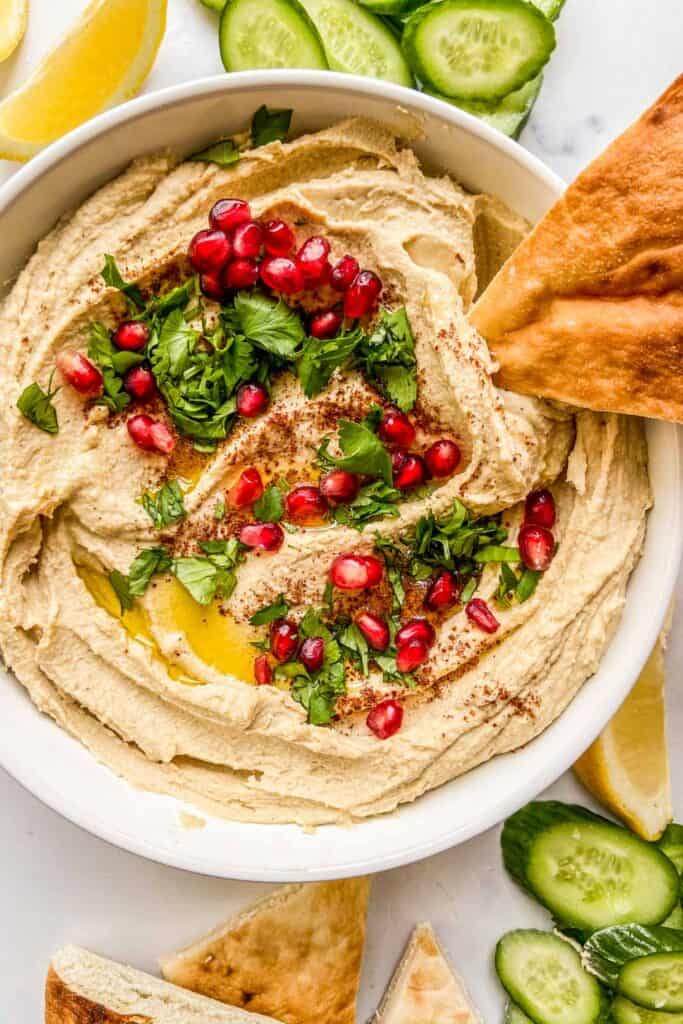
Why You’ll Love this Creamy Hummus
Hummus is a fabulous, all-purpose dip. Serve it with some cut veggies or toasted pita, spread it on a sandwich, or add it to a buddha bowl.
If you've had hummus at a great Arabic restaurant you know how absolutely creamy and delightful it can be when it's fresh.
Store-bought hummus may have quite a few stabilizers and preservatives - it works when you want quick hummus, but if you have the opportunity it's well worth making your own. You will absolutely be able to tell the difference.
What You'll Need for this Recipe
What is hummus made of? Hummus usually consists of chickpeas (either dry or canned), tahini, lemon juice, garlic, salt, and olive oil.
For this recipe, we recommend canned chickpeas to save time, 1 cup of good tahini paste, ¼ cup freshly squeezed lemon juice, 4 cloves of garlic, some sea salt, and at least a tablespoon of olive oil.
To top your hummus, you might want parsley, toasted chickpeas, toasted pine nuts, or sliced tomatoes.
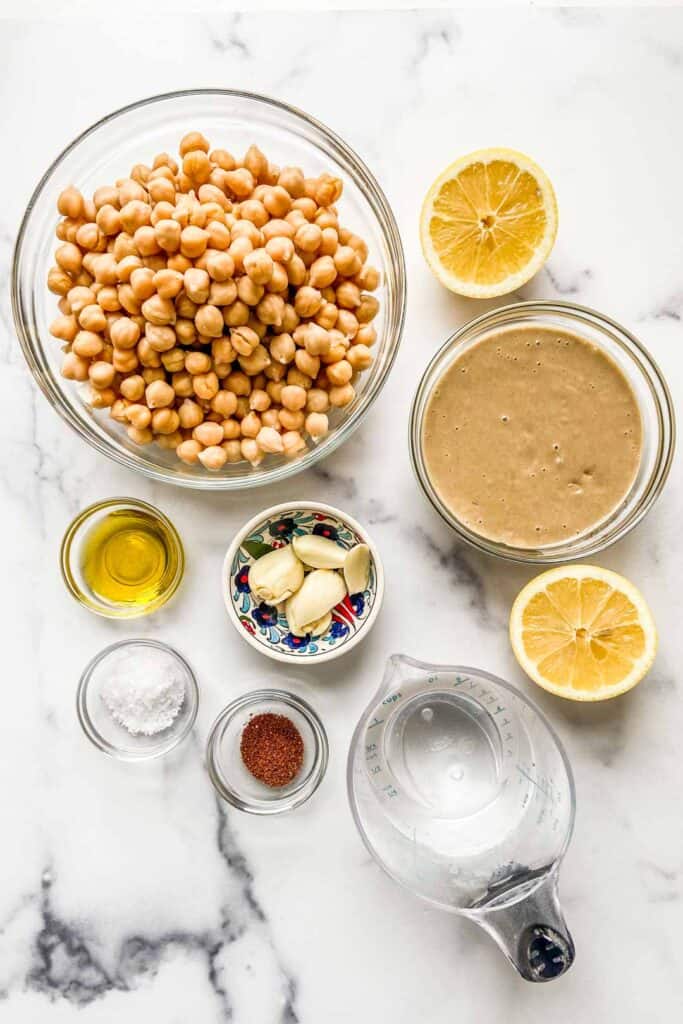
How to Make Hummus
This recipe is easy to make, but it has one essential step! You have to remove the skins from the chickpeas. This is the key to making the creamiest hummus.
- Prep the chickpeas. Drain and rinse the chickpeas. Using your hands, pop the skins off of each chickpea and discard the skins.
- Blend. Place the chickpeas in a food processor and pulse until you have a paste. Add in the tahini, lemon juice, garlic, and salt, continue to blitz the mixture.
- Adjust the consistency. Add in one tablespoon of water at a time and keep blending until you have a very creamy, smooth paste.
- Plate. Scoop the hummus out into a bowl, spreading it out with a spoon to create wells. Then drizzle with olive oil.
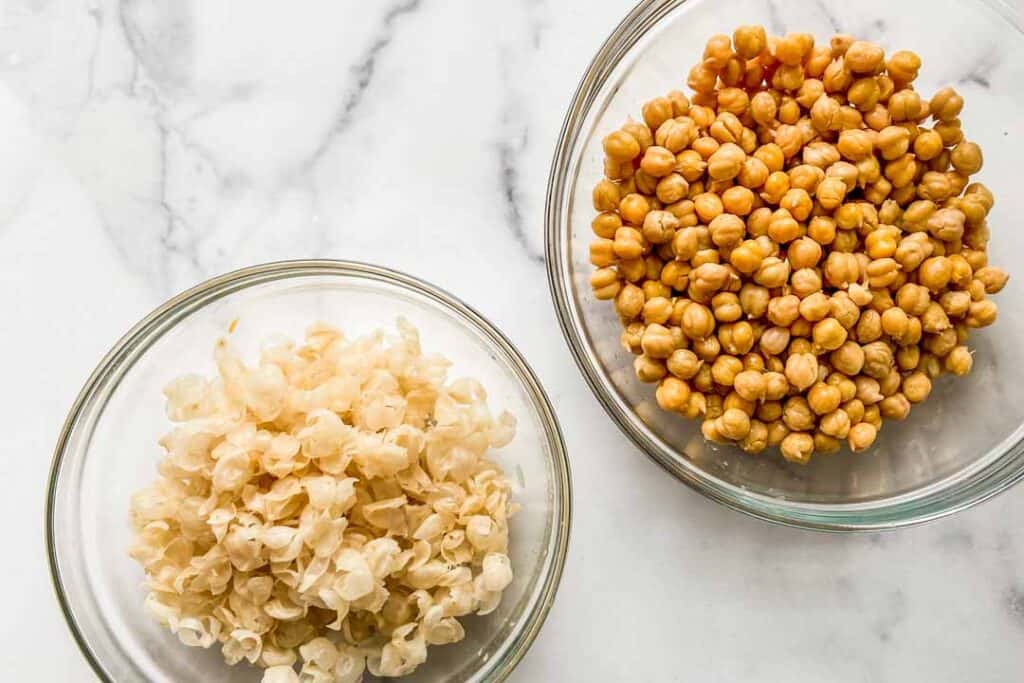
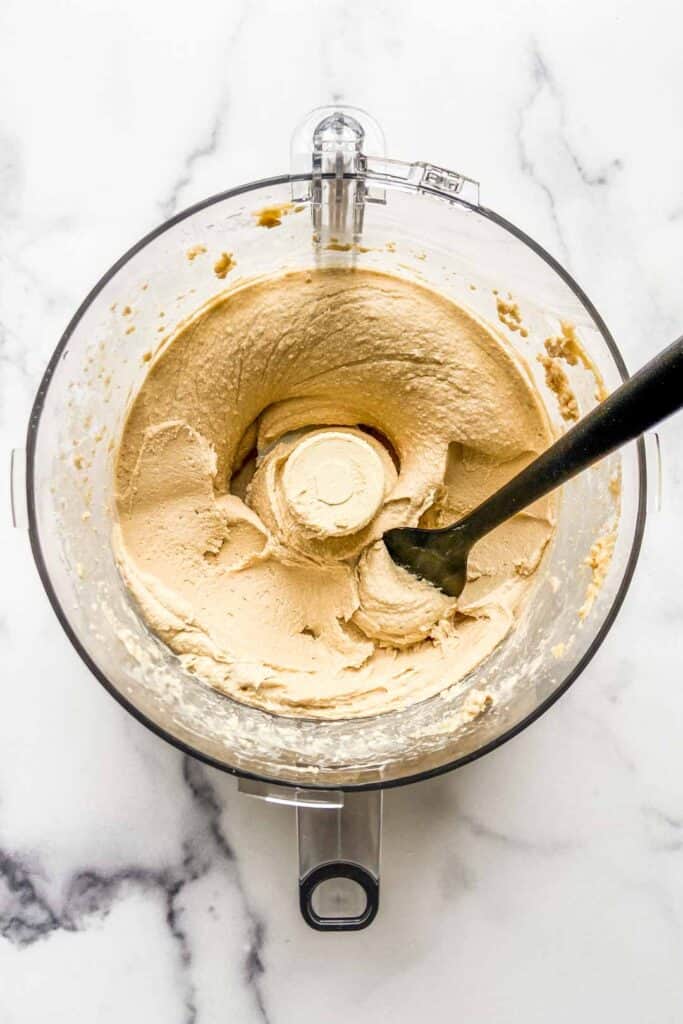
Other Mediterranean Appetizers You’ll Love
We love anything that can be served on a mezze plate. Here are some of our other favorite Mediterranean dips, spreads, and appetizers you can serve with hummus.
- Radish Tzatziki - a delicious radish, toasted walnut, and yogurt dip.
- Muhammara (Syrian Red Pepper Dip) - roasted red peppers combined with walnuts for a delightful tangy spread.
- Skordalia Recipe - a hearty potato spread that's great on toasted bread.
- How to Grill Halloumi - perfectly toasted halloumi cheese that's delicious on its own or added to a salad.
What to Serve with Hummus
Hummus is often served with warm pita bread, tabbouli, and falafel but here are some of our other favorite ways of using it/serving it in a meal.
- Serve it with lamb and squash or another seasonal vegetable. Hummus is often eaten as a main meal in the Middle East and can be topped with ground beef or lamb for a more substantial dish.
- Serve it with ful medames. Add the ful to a large bowl, create a well, and add in the hummus. Top with olive oil and serve with cucumbers and pita.
- Add it to a chicken shawarma platter. Spread out a layer of hummus and top it with chicken shawarma and veggies.
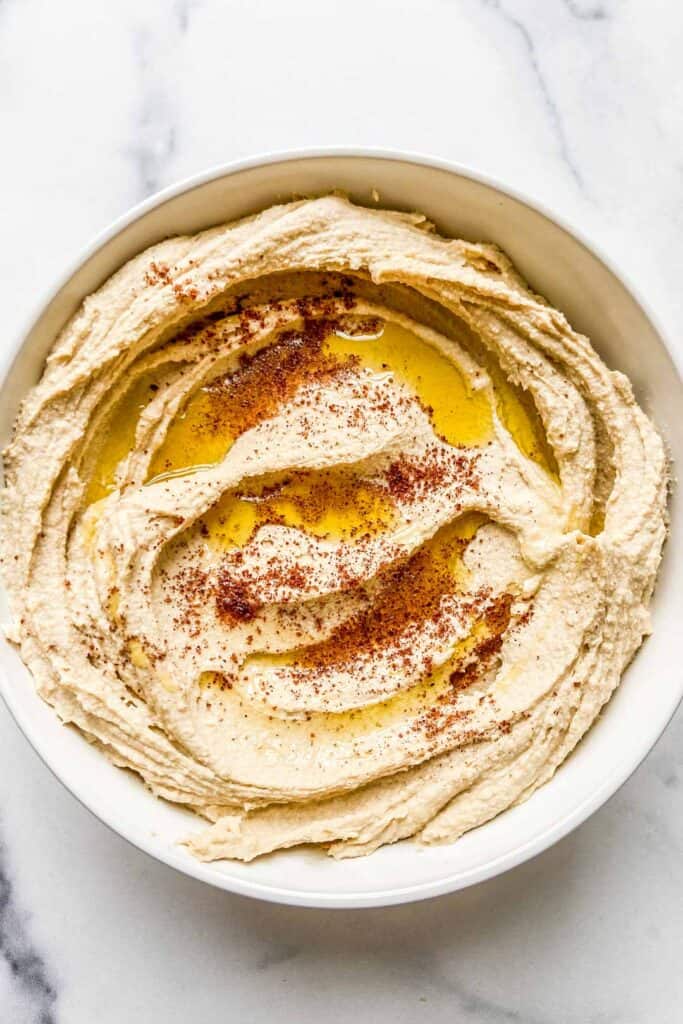
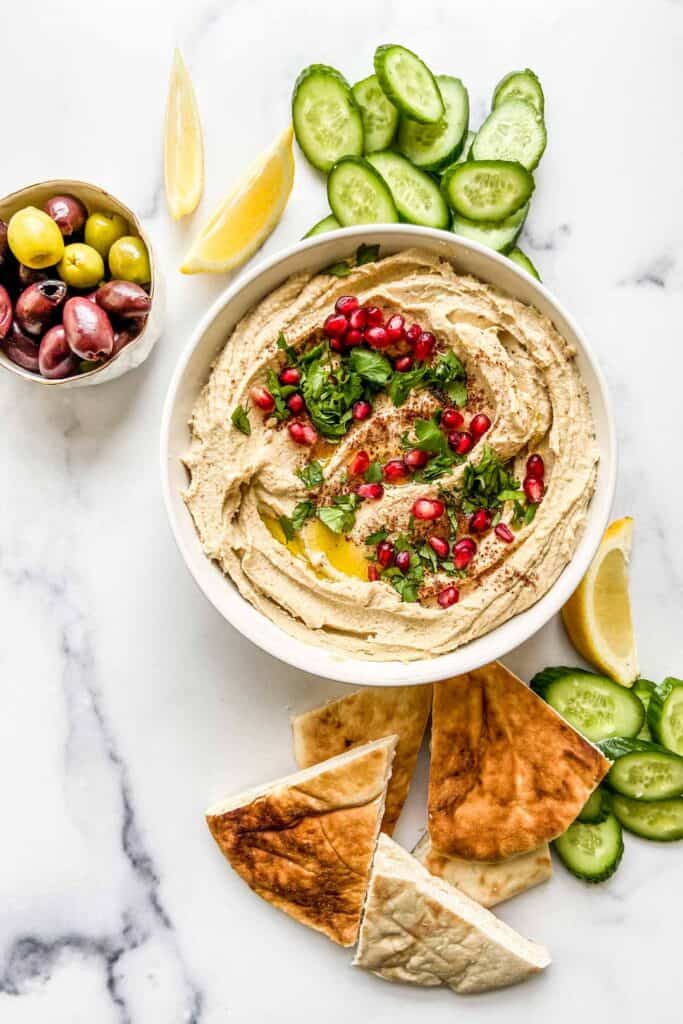
Tips for Making this Recipe
Links on some posts are affiliate links and as an Amazon Associate I earn from qualifying purchases.
Specialty Ingredients - The major flavor of hummus comes from the tahini you use, so you want to get the tastiest tahini possible! I like to use tahini from Arabic grocery stores, but I'm also a fan of Baron's Organic Tahini. Whole Foods tahini is good as well, but sadly I don't think the flavor of Trader Joe's tahini is quite right.
Recommended Tools - For this recipe, you'll need a food processor. I have two food processors I recommend. The first is the Cuisinart 14 Cup Food Processor (which I used for this recipe) - it's a higher-end machine that is worth every penny. It's fabulous for slicing and dicing, making dough, and blending soups and sauces.
The other food processor I can heartily recommend is the KitchenAid 3.5 Cup Food Chopper. It's great for smaller jobs and significantly cheaper.
Storing Tips - Hummus will save in the refrigerator for up to 5 days. It can be frozen as well; store it in an airtight container and freeze for up to 3 months.
Alternate Cooking Methods - If you'd prefer to use dry chickpeas for this recipe, you can use 2 cups of dried chickpeas. Soak them overnight in a large bowl with at least 2 inches of water covering them. Then bring them to a boil in a large pot of water with 1 teaspoon of salt and 1 teaspoon of baking soda, reduce to a simmer and cook for 1 hour. Skim any foam off the top and drain them. Then use them in the recipe like you would the canned chickpeas.
Creamy Hummus Recipe
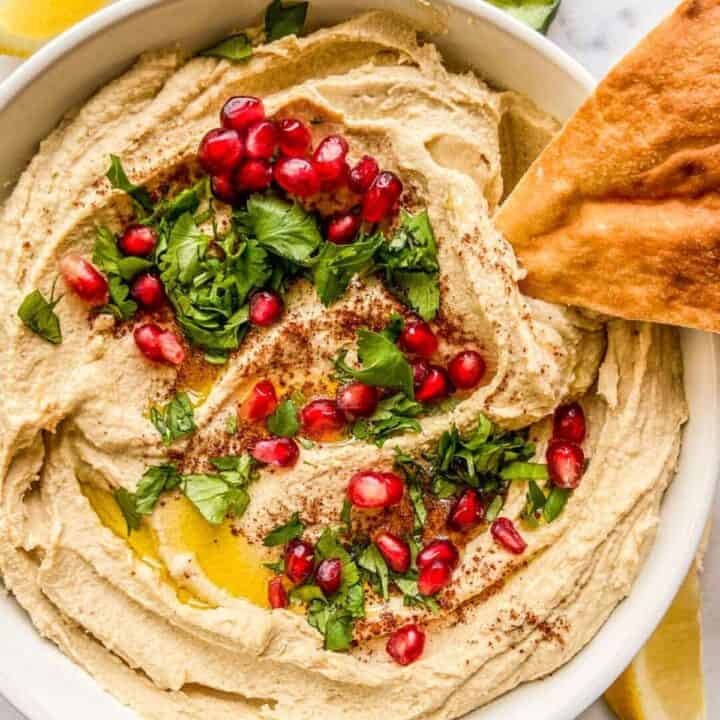
This delicious, homemade hummus recipe is the creamiest dip!
Ingredients
- 2 cans chickpeas, drained and rinsed
- 1 cup tahini paste
- ¼ cup freshly squeezed lemon juice
- 4 cloves garlic, crushed
- 1 teaspoon sea salt
- 6 tablespoons water
- 1 tablespoon olive oil
- ½ teaspoon sumac powder
Instructions
- Using your hands, pop the skins off of each chickpea and discard the skins. (This is tedious, but is what makes the hummus extra smooth and creamy!)
- Place the chickpeas in a food processor and pulse until you have a paste.
- Add in the tahini, lemon juice, garlic, and salt, continue to blitz the mixture.
- Add in the water a tablespoon and a time and keep blending until you have a very creamy, smooth paste.
- Scoop the hummus out into a bowl, spreading it out with a spoon to create wells. Then drizzle with olive oil and sprinkle with sumac.
- Top with optional chopped herbs, toasted chickpeas, pomegranate seeds, toasted pine nuts, or cherry tomatoes.
- Serve with warm pita bread, crackers, or crudités.
Nutrition Information:
Yield:
10Serving Size:
1Amount Per Serving: Calories: 251Total Fat: 16gSaturated Fat: 2gTrans Fat: 0gUnsaturated Fat: 13gCholesterol: 0mgSodium: 467mgCarbohydrates: 22gFiber: 6gSugar: 3gProtein: 9g
Hummus FAQs
Is hummus good for you?
Yes, hummus is good for you. Chickpeas are a powerhouse of nutrients and when combined with some olive oil and tahini for a nutrient-dense snack or meal.
According to Health, "One cup of ready-to-eat chickpeas contains 10 grams of protein and about 10 grams of dietary fiber—which is 40% of the daily minimum target. They are also packed with antioxidants and several other key nutrients."
Is hummus or avocado healthier?
While avocado might have fewer calories than hummus, it has less protein. They're both healthy choices, but hummus will keep your fuller for longer.
How do you make creamier hummus?
The easiest way to make creamy hummus is to remove the chickpea skins. They add extra grit to the hummus and will make the final result less smooth.
Where is hummus from?
Hummus (humus, homos, hoummos) likely originated in the Levant region of the Middle East or Egypt. There are a few written recipes from both regions in the 1400 and 1500s that resemble hummus. There are also early hummus-style recipes from Turkey.
Now hummus is a national dish in many countries like Israel (due to Palestinian influence), Syrian, Cyprus (due to Turkish influence), Jordan, and Lebanon. It regularly shows up on tables in the Middle East and is often eaten as part of dinner, and not as an appetizer.
What is tahini?
Tahini is a paste made from toasted ground sesame seeds. It's almost always used in hummus recipes, halva (a soft, Middle Eastern candy), and baba ghanoush (a roasted eggplant dip).